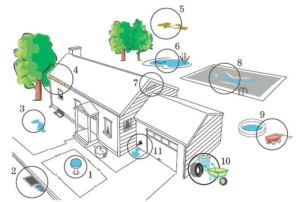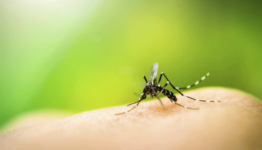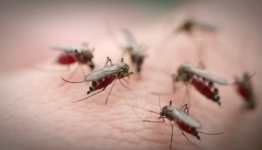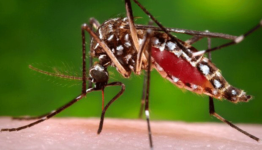There are several facts people do not know of mosquitoes. Below are six facts about mosquitoes which deal mainly with the Zika carrying mosquito.
- Their names sometimes sound weird
Scientifically, Aedes aegypti is the name by which Zika-borne-mosquitoes are known. They are sometimes referred to as the yellow fever mosquito. According to its name it is also a vector of yellow fever, chikungunya and Dengue.
- They can only cover a short distance.
Aedes aegypti can only fly short distances. It can only cover a distance not more than 200 feet as it searches for a water container suitable for breeding. All its life activities are done within this perimeter.
- Without water, their lifecycle may break
Stagnant water is essential for the breeding process of mosquitoes, even if it’s just an inch deep. It takes just about 7-8 days for the egg of a mosquito to develop into the adult stage.
- They easily find comfort in their chosen habitat.
Mosquitoes can successfully inhabit any given environment provided the surrounding conditions are suitable. For instance, natural or artificial water containers located close to human residence are suitable habitat which favors egg production.
- The males don’t suck blood.
Whenever you catch a mosquito biting your skin, be rest assured a female mosquito was the culprit. Protein present in the blood is essential for laying eggs. This fact is put into high consideration as scientists try to discover ways of reducing the possibilities of infection in areas infested by Aedes aegypti. What’s more – they bite with proboscis due to the absence of teeth.
- Best possible ways of preventing Zika and outbreak of other disease is to prevent its bite
These insects are vectors of dangerous diseases. Avoiding its bite is the best way to stay safe. This can be achieved by ensuring that there are no stagnant water around no matter how little, use of repellent and wearing of clothes that cover your body completely.
More facts about mosquitoes
Although mosquitoes cannot be classified as most popular pest, they are very fascinating. Below are some amazing facts about them. Perhaps, you might end up liking them.
- Mosquitoes can breed in several other places other than stagnant water

There could be other breading sites of mosquitoes around you are not aware of. After ensuring that water in flower pots, old tires and bird baths are emptied out, ensure your ditches and gutters are constantly clean. Or put a mesh over them so as to prevent storage of water by dirt and leaves. Other possible breeding locations where water can be collected includes, landscape statues, car, children’s toys, playground equipment, birdbath, old tires, untouched buckets etc. Small pockets can be formed on a plastic waste bins siting under the rain hence can collect water and encourage breeding of mosquitoes. Never forget that even the smallest amount of stagnant water can be sufficient for their breeding. Since your neighbor’s yard isn’t free of stagnant water yours might be affected as well.
- Mosquitoes are mostly very active in April till October.
Depending on the country, mosquitoes can start their activities in April. Months later, probably in July, their breeding would start running till September. The best period for the West Nile Virus begins from late August to early September and can be extended to October in certain places. Before the mosquitoes kiss life goodbye, temperature must have fallen to as low as freeing point.
- Although the best site for laying eggs is in water, however their eggs are capable of staying alive on moist and dirty ground.
Edges of standing water with presence of refuge, grass or foliage are more suitable for egg laying by mosquitoes since they are able to sustain the eggs on water surface. The egg fails to completely develop and dies if the water is emptied or becomes dry within few days (7-10) after it was laid. The egg can stay in cyst form for months in moist land while waiting for sufficient water needed for its development and feeding.
- The most active period of mosquitoes is when the lights are out.
There are various species of mosquitoes which are over 3000 in number while over 190 of them are found in the United States. Mosquitoes come out to hunt for blood mostly at nights or early hours of the morning. Some species, however are so aggressive that they bite both at night and day.
Caution should be observed when controlling mosquitoes. Below are some recommendations by experts in order to ensure protection:
- Yellow bulbs should be used as outdoor bulbs in place of white bulbs since mosquitoes are less attracted to them
- Wear long sleeves and pants as well. Only repellents approved by EPA should be used.
- Contact professional pest Control Company for proper inspection and treatment of your yard if infested.
- Avoid going out at nights and the wee hours of the morning.
- They are slow
They fall within the category of the slowest flying insect with a speed rate of 1-1 and a half miles per hour although they weigh slightly less than a grain of rice.
- They are of various species
There are over 2,700 species recognized globally with some record numbering up to 3,000. About 176 species are have made North America their home.
- CO2 Sensitivity
The presence of CO2 in the atmosphere serves as an indication of the presence of blood nearby for mosquitoes; hence mosquitoes can easily locate us via the carbon dioxide we exhale
8. They are older than humanity.
Mosquitoes are known to have existed as far back as half a billion years ago when humanity hasn’t even started. This means that they have higher withstanding ability than the dinosaurs.
- Females bite at all times of the day.
This might seem unbelievable; the male mosquito feeds mainly on flower nectar while only the female survives on blood meal.
- Most deadly creature in the world.
Mosquitoes are the most deadly creature in the world as they are vectors of dangerous diseases. Their bites have led to the highest death number of animals.










